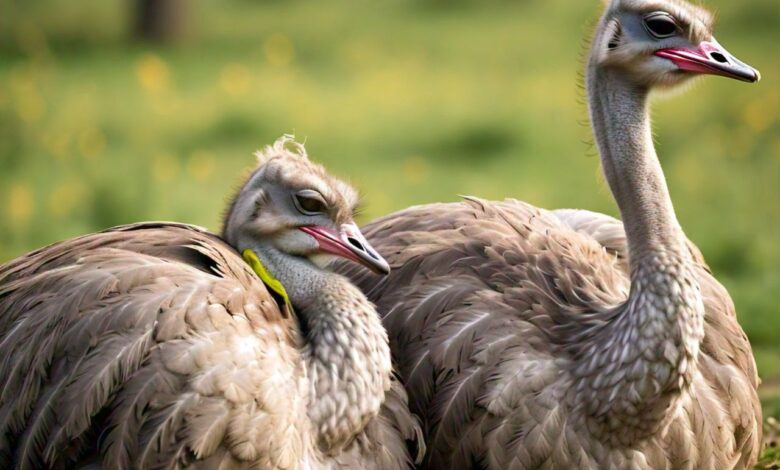All About Ostriches: Detailed Facts and Figures

All About Ostriches: Detailed Facts and Figures
Ostriches are fascinating creatures known for their size, speed, and unique behaviors. As the largest living birds in the world, they possess many remarkable traits that set them apart from other avian species. In this comprehensive guide, we will explore various aspects of ostriches, including their physical characteristics, habitat, behavior, diet, and more.
1. Physical Characteristics of Ostriches
Ostriches are distinctive for their large size and long necks. They can stand up to 9 feet tall and weigh between 220 to 350 pounds. Their wings, although not suitable for flight, are long and powerful, helping them maintain balance while running. An adult ostrich typically has two toes on each foot, adapted for running at high speeds.
1.1 Ostrich Eggs
One of the most remarkable features of ostriches is their eggs, which are the largest of any bird species. An ostrich egg can weigh about 3 pounds and measure 6 inches in diameter. These eggs are not only large but also incredibly strong, capable of supporting the weight of an adult human.
For more information on the size of ostrich eggs, visit this informative article.
2. Habitat and Distribution
Ostriches are native to Africa, primarily inhabiting the savannas and open grasslands of sub-Saharan regions. They thrive in warm climates and prefer areas with plenty of space to roam and forage. While they are primarily ground-dwelling birds, they are also capable of adapting to various environments, including semi-arid regions.
3. Behavior and Social Structure
Ostriches are social animals that often live in groups or flocks ranging from 5 to 50 individuals. These groups are typically composed of females, males, and their young. Ostrich behavior is fascinating, as they display a range of social interactions, from mating rituals to group foraging.
3.1 Dancing and Courtship Rituals
One of the most intriguing behaviors of ostriches is their courtship dance. During mating season, male ostriches perform elaborate displays that involve flapping their wings, puffing out their necks, and moving in circles to attract females. This dance is not only a visual spectacle but also an essential part of their mating ritual.
To learn more about why ostriches dance for humans, check out this detailed article.
4. Diet of Ostriches
Ostriches are omnivores, primarily feeding on a varied diet of plants, seeds, fruits, and insects. They have a unique digestive system that allows them to break down tough plant materials efficiently. Their foraging habits often involve grazing on grasses and shrubs while occasionally searching for small invertebrates.
4.1 Adaptations for Digestion
To aid in digestion, ostriches ingest small stones and grit, which help grind down food in their gizzards. This adaptation allows them to extract maximum nutrients from their diet, making them well-suited for their habitat.
5. Reproduction and Nesting
Ostriches are known for their unique nesting behaviors. The female ostrich lays a clutch of 15 to 20 eggs, which are then incubated by both parents. The male typically takes the night shift, while the female incubates during the day. This shared responsibility ensures that the eggs are kept warm and protected.
5.1 Hatching and Chick Development
Ostrich chicks are precocial, meaning they are relatively mature and mobile shortly after hatching. They can run and forage within a few days, making them less vulnerable to predators. However, they rely on their parents for protection and guidance during the early stages of life.
6. Speed and Movement
Ostriches are the fastest-running birds in the world, capable of reaching speeds of up to 45 miles per hour. Their long legs and powerful muscles allow them to cover large distances quickly, making them adept at escaping predators. They can maintain a steady running speed of 30 miles per hour over long distances, thanks to their efficient stride.
7. Predators and Threats
Despite their size and speed, ostriches face threats from various predators, including lions, hyenas, and crocodiles. Their primary defense mechanism is to run away; however, when cornered, they can deliver powerful kicks capable of injuring or killing an attacker.
7.1 Conservation Status
Ostriches are not currently endangered, but habitat loss and hunting pose significant threats to some populations. Conservation efforts aim to protect their habitats and promote sustainable practices to ensure their survival in the wild.
8. Cultural Significance
Ostriches have played a significant role in various cultures throughout history. They are often associated with myths and legends, symbolizing speed, strength, and resilience. Additionally, ostrich feathers have been highly valued in fashion and ceremonial attire.
9. Ostrich Farming
Ostrich farming has gained popularity in recent years due to the demand for ostrich meat, feathers, and leather. These farms contribute to local economies and promote sustainable practices in agriculture. Ostrich meat is considered a healthier alternative to traditional red meats, being low in fat and high in protein.
10. Common Misconceptions
Many myths surround ostriches, particularly the belief that they bury their heads in the sand when frightened. In reality, ostriches do not exhibit this behavior; instead, they may flatten themselves against the ground to avoid detection from predators.
11. The Ostrich’s Unique Anatomy
Ostriches possess several unique anatomical features, including:
- Large Eyes: Their eyes are among the largest of any land animal, providing excellent vision to spot potential threats.
- Strong Legs: Their legs are powerful and muscular, enabling them to run swiftly and deliver forceful kicks.
- Adapted Respiratory System: Ostriches have a specialized respiratory system that allows them to take in large amounts of oxygen while running.
12. Sleep Patterns
Ostriches have distinct sleep patterns that involve short bouts of sleep throughout the day and night. They are known to sleep while standing, although they may also lie down when they feel safe. This ability to sleep while standing helps them remain vigilant against potential predators.
For more details about how ostriches sleep, refer to this in-depth article.
13. Interesting Facts About Ostriches
- Ostriches have a strong sense of smell and can detect food and predators from a distance.
- They can live up to 40 years in captivity and around 30 years in the wild.
- Ostrich feathers are highly sought after for their unique appearance and soft texture.
14. Ostrich Communication
Ostriches communicate using various vocalizations and body language. They produce different sounds to signal alarm, mating calls, or social interactions. Their body language, such as puffing their feathers or performing courtship dances, also conveys important information to other ostriches.
15. Conclusion: The Majestic Ostrich
Ostriches are extraordinary birds that captivate the imagination with their unique traits and behaviors. From their impressive size and speed to their fascinating social structures and nesting habits, ostriches continue to intrigue researchers and wildlife enthusiasts alike. By understanding these incredible creatures, we can appreciate their role in the ecosystem and the importance of conserving their habitats.
For more information on various bird species and their behaviors, visit this comprehensive resource.


